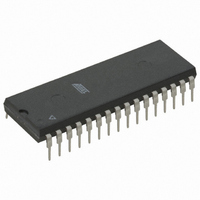AT29C020-70PC Atmel, AT29C020-70PC Datasheet - Page 2

AT29C020-70PC
Manufacturer Part Number
AT29C020-70PC
Description
IC FLASH 2MBIT 70NS 32DIP
Manufacturer
Atmel
Datasheet
1.AT29C020-70PC.pdf
(17 pages)
Specifications of AT29C020-70PC
Format - Memory
FLASH
Memory Type
FLASH
Memory Size
2M (256K x 8)
Speed
70ns
Interface
Parallel
Voltage - Supply
4.5 V ~ 5.5 V
Operating Temperature
0°C ~ 70°C
Package / Case
32-DIP (0.600", 15.24mm)
Lead Free Status / RoHS Status
Contains lead / RoHS non-compliant
Available stocks
Company
Part Number
Manufacturer
Quantity
Price
Block Diagram
Device
Operation
2
AT29C020
To allow for simple in-system reprogrammability, the AT29C020 does not require high input
voltages for programming. Five-volt-only commands determine the operation of the device.
Reading data out of the device is similar to reading from an EPROM. Reprogramming the
AT29C020 is performed on a sector basis; 256 bytes of data are loaded into the device and
then simultaneously programmed.
During a reprogram cycle, the address locations and 256 bytes of data are internally latched,
freeing the address and data bus for other operations. Following the initiation of a program
cycle, the device will automatically erase the sector and then program the latched data using
an internal control timer. The end of a program cycle can be detected by DATA polling of I/O7.
Once the end of a program cycle has been detected, a new access for a read or program can
begin.
READ: The AT29C020 is accessed like an EPROM. When CE and OE are low and WE is
high, the data stored at the memory location determined by the address pins is asserted on
the outputs. The outputs are put in the high impedance state whenever CE or OE is high. This
dual-line control gives designers flexibility in preventing bus contention.
BYTE LOAD: Byte loads are used to enter the 256 bytes of a sector to be programmed or
the software codes for data protection. A byte load is performed by applying a low pulse on the
WE or CE input with CE or WE low (respectively) and OE high. The address is latched on the
falling edge of CE or WE, whichever occurs last. The data is latched by the first rising edge of
CE or WE.
PROGRAM: The device is reprogrammed on a sector basis. If a byte of data within a sector
is to be changed, data for the entire sector must be loaded into the device. Any byte that is not
loaded during the programming of its sector will be indeterminate. Once the bytes of a sector
are loaded into the device, they are simultaneously programmed during the internal program-
ming period. After the first data byte has been loaded into the device, successive bytes are
entered in the same manner. Each new byte to be programmed must have its high-to-low tran-
sition on WE (or CE) within 150 µs of the low-to-high transition of WE (or CE) of the preceding
byte. If a high-to-low transition is not detected within 150 µs of the last low-to-high transition,
the load period will end and the internal programming period will start. A8 to A17 specify the
sector address. The sector address must be valid during each high-to-low transition of WE (or
CE). A0 to A7 specify the byte address within the sector. The bytes may be loaded in any
order; sequential loading is not required. Once a programming operation has been initiated,
and for the duration of t
WC
, a read operation will effectively be a polling operation.
0291N–FLASH–07/02















